Methods and Methodologies for Congestion Alleviation in the DPS: A Comprehensive Review
Abstract
1. Introduction
2. Methods to Alleviate Congestion
- (a)
- System disturbances causing added outages in an interrelated system;
- (b)
- Reduced market efficiency;
- (c)
- Hike in energy prices;
- (d)
- With an increase in electricity charges, the loads are enforced to decrease the power consumption;
- (e)
- Adverse security concerns;
- (f)
- Operation of the system with stability margins;
- (g)
- Frequent initiation of cascade tripping.
2.1. Cost-Free Methods
2.1.1. Application of a Flexible AC Transmission System (FACTS)
2.1.2. Phase Shifting Transformers
2.1.3. Network Reconfiguration
2.1.4. Available Transfer Capacity (ATC) Enhancement-Based CM
2.2. Non-Cost-Free Methods
2.2.1. Congestion Alleviation by Generator Rescheduling and Load Curtailment
2.2.2. First-Come, First-Served (FCFS) and Pro-Rata Method
2.2.3. Auction-Based Methods
2.2.4. Load Curtailment-Based Methods
2.2.5. Nodal Pricing (NP) Methods
2.2.6. Distributed Generation (DG) Method for CM
3. Optimization Algorithms for CM
3.1. Genetic Algorithm (GA)
| Algorithms 1: GA |
| 1: Initialize |
| for random population Gm = 0 at t = 0; |
| randomly create individuals in initial population p(t) |
| Gm = population of n randomly generated individuals; |
| 2: Evaluate Gm: Calculate fitness(j) for all j ∈ Gm; |
| 3: Do |
| Initiate iteration m = 0 |
| 4: Copy: Select (1 − γ) × n members of Gm and insert into Gm + 1; |
| 5: Crossover: Select γ × n members of Gm; |
| do pairing; |
| harvest offspring; |
| add offspring into Gm + 1; |
| 6: Mutate: Choose χ × n members of Gm + 1; |
| reverse a randomly chosen bit in each; |
| 7: Evaluate: Gm + 1: |
| calculate fitness(j) for all j ∈ Gm; |
| 8: Increase the iteration counter m = m + 1; |
| if the termination criteria is not satisfied |
| go to step 4 |
| else, return the best individual |
| end |
3.2. Particle Swarm Optimization (PSO)
| Algorithm 2: PSO |
| 1: Initialize: |
| for swarm population with dimension d in S |
| 2: Initialize: |
| random particle location: n(j, d) = rand (nmin, nmax) and |
| random velocity in S:v (j, d0) = rand (vmin, vmax) |
| end for |
| particle j, best position Pbj = nj |
| 3: Apprise global best location of j: Gb |
| if Pbj < Gb |
| substitute Gb = Pbj |
| end if |
| end for |
| 4: Appraise each particle’s best location in S |
| if nj < Pbj then Pbj = nj |
| end if |
| 5: Appraise particle velocity: |
| also, the position, |
| 6: Increase the iteration iter = iter + 1 till iter = itermax. |
3.3. Grey Wolf Optimization (GWO)
| Algorithm 3: GWO |
| 1: Initialize |
| GWO variables (a, A & C) |
| population randomly, n |
| iteration counter, itr = 0 |
2: Calculate the fitness of all wolves
|
| end for |
| if |
| position vectors Xα, Xβ, and Xγ give a better fitness than previous |
| while: itr < itr_max |
| return: the best fitness, Xα |
| else, |
| advance the itr count, itr + 1 |
| end if |
| go to step 2 |
3.4. Teaching Learning-Based Optimization (TLBO)
| Algorithm 4: TLBO |
| 1: Initialize learner population, Np in dimension D; |
| 2: Evaluate learners |
| 3: While the termination condition is not true |
| select best learner, Xteacher & find the mean of the rest of the learners, Xmean |
4: For individual learner
|
| end for |
| end while |
3.5. JAYA Algorithm (JAYA)
| Algorithm 5: JAYA |
| //Initialize population size, p; maximum iteration, itr_max & design variables, I; |
| 1: Randomly select the best fitness candidate and worst fitness candidate |
| 2: Appraise the fitness value of the candidate by |
| 3: |
| update the new solution |
| else, consider the previous solution |
| if the termination criteria satisfied |
| Return: consider the solution as optimum |
| else, go to step 2 |
4. Conclusions
Author Contributions
Funding
Informed Consent Statement
Data Availability Statement
Conflicts of Interest
Nomenclature
| DPS | Deregulated power system |
| EPS | Electrical power system |
| GENCOS | Generation companies |
| TRANSCOS | Transmission companies |
| DISCOS | Distribution companies |
| PX | Power exchangers |
| ISO | Independent system operator |
| TSO | transmission system operator |
| CM | Congestion management |
| FACTS | Flexible alternating current transmission systems |
| ATC | Available transfer capability |
| TTC | Total transfer capacity |
| TRM | Transmission reliability margin |
| ETC | Existing transmission commitment |
| CBM | Capacity benefit margin |
| P | Active power |
| Q | Reactive power |
| GTO | Gate turn off thyristor |
| PST | Phase shifting transformer |
| DT | Dynamic tariff |
| WG | Wind generator |
| TCDF | Transmission congestion distribution factor |
| PTDF | Power transmission distribution factor |
| GR | Generator rescheduling |
| LC | Load curtailment |
| RED | Relative electrical distance |
| GSF | Generator sensitivity factor |
| FCFS | First come first serve |
| LMP | Locational marginal price |
| NP | Nodal pricing |
| DG | Distributed generation |
| WPP | Wind power plant |
| RES | Renewable energy resources |
| AI | Artificial Intelligence |
| GA | Genetic algorithm |
| GWO | Grey wolf algorithm |
| PSO | Particle swarm optimization |
| TLBO | Teaching learning-based algorithm |
| DR | Demand response |
| OTS | Optimal transmission switching |
References
- Karthikeyan, P.; Jacob Raglend, I.; Kothari, D.P. A Review on Market Power in Deregulated Electricity Market. Int. J. Electr. Power Energy Syst. 2013, 48, 139–147. [Google Scholar] [CrossRef]
- Yousefi, A.; Nguyen, T.T.; Zareipour, H.; Malik, O.P. Congestion Management Using Demand Response and FACTS Devices. Int. J. Electr. Power Energy Syst. 2012, 37, 78–85. [Google Scholar] [CrossRef]
- Pillay, A.; Prabhakar Karthikeyan, S.; Kothari, D.P. Congestion Management in Power Systems—A Review. Int. J. Electr. Power Energy Syst. 2015, 70, 83–90. [Google Scholar] [CrossRef]
- Vengadesan, A. Transmission Congestion Management through Optimal Placement and Sizing of TCSC Devices in a Deregulated Power Network. Turk. J. Comput. Math. Educ. 2021, 12, 5390–5403. [Google Scholar]
- Bachtiar Nappu, M.; Arief, A.; Bansal, R.C. Transmission Management for Congested Power System: A Review of Concepts, Technical Challenges and Development of a New Methodology. Renew. Sustain. Energy Rev. 2014, 38, 572–580. [Google Scholar] [CrossRef]
- Jain, R.; Mahajan, V. Load Forecasting and Risk Assessment for Energy Market with Renewable Based Distributed Generation. Renew. Energy Focus 2022, 42, 190–205. [Google Scholar] [CrossRef]
- Gumpu, S.; Pamulaparthy, B.; Sharma, A. Review of Congestion Management Methods from Conventional to Smart Grid Scenario. Int. J. Emerg. Electr. Power Syst. 2019, 20. [Google Scholar] [CrossRef]
- Khan, I.; Mallick, M.A.; Rafi, M.; Mirza, M.S. Optimal Placement of FACTS Controller Scheme for Enhancement of Power System Security in Indian Scenario. J. Electr. Syst. Inf. Technol. 2015, 2, 161–171. [Google Scholar] [CrossRef]
- Larsen, E.V.; Miller, N.W.; Nilsson, S.L.; Lindgren, S.R. Benefits of GTO-Based Compensation Systems for Electric Utility Applications. IEEE Trans. Power Deliv. 1992, 7, 2056–2064. [Google Scholar] [CrossRef]
- Samimi, A.; Golkar, M.A. A Novel Method for Optimal Placement of FACTS Based on Sensitivity Analysis for Enhancing Power System Static Security. Asian J. Appl. Sci. 2011, 5, 1–19. [Google Scholar] [CrossRef]
- Besharat, H.; Taher, S.A. Congestion Management by Determining Optimal Location of TCSC in Deregulated Power Systems. Int. J. Electr. Power Energy Syst. 2008, 30, 563–568. [Google Scholar] [CrossRef]
- Singh, S.N.; David, A.K. Optimal Location of FACTS Devices for Congestion Management. Electr. Power Syst. Res. 2001, 58, 71–79. [Google Scholar] [CrossRef]
- Sepahvand, H. Optimal location and setting of TCSC and TCPST to reduce transmission congestion in deregulated electricity marke. Int. J. Energy Convers. (IRECON) 2013, 1, 47–56. [Google Scholar]
- Esmaili, M.; Shayanfar, H.A.; Moslemi, R. Locating Series FACTS Devices for Multi-Objective Congestion Management Improving Voltage and Transient Stability. Eur. J. Oper. Res. 2014, 236, 763–773. [Google Scholar] [CrossRef]
- Chong, B.; Zhang, X.P.; Godfrey, K.R.; Yao, L.; Bazargan, M. Optimal Location of Unified Power Flow Controller for Congestion Management. Eur. Trans. Electr. Power 2009, 20, 600–610. [Google Scholar] [CrossRef]
- Anubha Gautam, P.R.S.Y.K. Sensitivity Based Congestion Management in a Deregulated Power System by Optimal Allocation & Parameter Setting of TCSC Using Grey Wolf Optimization. Int. J. Electr. Eng. Inform. 2020, 12, 890–911. [Google Scholar]
- Saptarshi Roy, P.S.B. Optimal Placement of Tcsc and Tcpar Using Sensitivity Analysis. J. Electr. Eng. 2018, 19, 14. [Google Scholar]
- Dhouib, B.; Alaas, Z.; Kahouli, O.; Haj Abdallah, H. Determination of Optimal Location of FACTS Device to Improve Integration Rate of Wind Energy in Presence of MBPSS Regulator. IET Renew. Power Gener. 2020, 14, 3526–3540. [Google Scholar] [CrossRef]
- Jamnani, J.G.; Pandya, M. Coordination of SVC and TCSC for Management of Power Flow by Particle Swarm Optimization. Energy Procedia 2019, 156, 321–326. [Google Scholar] [CrossRef]
- Chaithanya, K.K.; Kumar, G.V.N.; Rafi, V.; Kumar, B.S. Optimal Setting of Interline Power Flow Controller in Deregulated Power Systems Congestion Management by Using Artificial Intelligent Controllers. J. Phys. Conf. Ser. 2021, 2070, 012127. [Google Scholar] [CrossRef]
- Mishra, A.; Kumar, G.V.N. Congestion Management of Deregulated Power Systems by Optimal Setting of Interline Power Flow Controller Using Gravitational Search Algorithm. J. Electr. Syst. Inf. Technol. 2017, 4, 198–212. [Google Scholar] [CrossRef]
- Siddiqui, A.S.; Khan, S.; Ahsan, S.; Khan, M.I. Annamalai Application of Phase Shifting Transformer in Indian Network. In Proceedings of the 2012 International Conference on Green Technologies (ICGT), Kerala, India, 18–20 December 2012; pp. 186–191. [Google Scholar]
- Guha Thakurta, P.; van Hertem, D.; Belmans, R. An Approach for Managing Switchings of Controllable Devices in the Benelux to Integrate More Renewable Sources. In Proceedings of the 2011 IEEE Trondheim PowerTech, Trondheim, Norway, 19–23 June 2011; pp. 1–7. [Google Scholar]
- Korab, R.; Owczarek, R.; Połomski, M. Coordination of Phase Shifting Transformers by Means of the Swarm Algorithm. Elektr. Zesz. 2017, 63, 37–47. [Google Scholar]
- Granelli, G.; Montagna, M.; Zanellini, F.; Bresesti, P.; Vailati, R.; Innorta, M. Optimal Network Reconfiguration for Congestion Management by Deterministic and Genetic Algorithms. Electr. Power Syst. Res. 2006, 76, 549–556. [Google Scholar] [CrossRef]
- Sengupta, S.; Sen, S.; Pal, S. Power Network Reconfiguration For Congestion Management And Loss Minimization Using Genetic Algorithm. In Proceedings of the Michael Faraday IET International Summit 2015, Kolkata, India, 12–13 September 2015; pp. 50–56. [Google Scholar]
- Shen, F.; Huang, S.; Wu, Q.; Repo, S.; Xu, Y.; Ostergaard, J. Comprehensive Congestion Management for Distribution Networks Based on Dynamic Tariff, Reconfiguration, and Re-Profiling Product. IEEE Trans Smart Grid 2019, 10, 4795–4805. [Google Scholar] [CrossRef]
- Narain, A.; Srivastava, S.K.; Singh, S.N. A Novel Sensitive Based Approach to ATC Enhancement in Wind Power Integrated Transmission System. SN Appl. Sci. 2021, 3, 563. [Google Scholar] [CrossRef]
- Bavithra, K.; Raja, S.C.; Venkatesh, P. Optimal Setting of FACTS Devices Using Particle Swarm Optimization for ATC Enhancement in Deregulated Power System. IFAC-PapersOnLine 2016, 49, 450–455. [Google Scholar] [CrossRef]
- Gupta, D.; Jain, S.K. Available Transfer Capability Enhancement by FACTS Devices Using Metaheuristic Evolutionary Particle Swarm Optimization (MEEPSO) Technique. Energies 2021, 14, 869. [Google Scholar] [CrossRef]
- Charles Raja, S.; Venkatesh, P.; Manikandan, B.V. Transmission Congestion Management in Restructured Power Systems. In Proceedings of the 2011 International Conference on Emerging Trends in Electrical and Computer Technology, Nagercoil, India, 23–24 March 2011; pp. 23–28. [Google Scholar]
- Mahouna Houndjéga, C.M.M.C.W.W. Active Power Rescheduling for Congestion Management Based on Generator Sensitivity Factor Using Ant Lion Optimization Algorithm. Int. J. Eng. Res. Technol. 2018, 11, 1565–1582. [Google Scholar]
- Sankaramurthy, P.; Chokkalingam, B.; Padmanaban, S.; Leonowicz, Z.; Adedayo, Y. Rescheduling of Generators with Pumped Hydro Storage Units to Relieve Congestion Incorporating Flower Pollination Optimization. Energies 2019, 12, 1477. [Google Scholar] [CrossRef]
- Yesuratnam, G.; Thukaram, D. Congestion Management in Open Access Based on Relative Electrical Distances Using Voltage Stability Criteria. Electr. Power Syst. Res. 2007, 77, 1608–1618. [Google Scholar] [CrossRef]
- Nesamalar, J.J.D.; Venkatesh, P.; Raja, S.C. Energy Management by Generator Rescheduling in Congestive Deregulated Power System. Appl. Energy 2016, 171, 357–371. [Google Scholar] [CrossRef]
- Gope, S.; Goswami, A.K.; Tiwari, P.K.; Deb, S. Rescheduling of Real Power for Congestion Management with Integration of Pumped Storage Hydro Unit Using Firefly Algorithm. Int. J. Electr. Power Energy Syst. 2016, 83, 434–442. [Google Scholar] [CrossRef]
- Salkuti, S.R. Multi-Objective Based Congestion Management Using Generation Rescheduling and Load Shedding. IEEE Trans. Power Syst. 2016, 32, 852–863. [Google Scholar] [CrossRef]
- Kaushik Paul, N.K.D.H.A. Congestion Management Based on Real Power Rescheduling Using Moth Flame Optimization. Recent Adv. Power Syst. 2020, 699, 365–376. [Google Scholar]
- Ramachandran, M.A.R. Real and Reactive Power Rescheduling for Congestion Management Based on Generator Sensitivity Index. IOSR J. Electr. Electron. Eng. 2016, 11, 41–48. [Google Scholar]
- Shinkai, M. Congestion Management in Japan. In Proceedings of the International Symposium CIGRE/IEEE PES, San Antonio, TX, USA, 5–7 October 2005; pp. 17–23. [Google Scholar]
- Od, G.; Bhongade, K.M.L.V. Transmission Congestion Management in Restructured Power Systems. Int. J. Adv. Res. Electr. Electron. Instrum. Eng. 2015, 4, 5977–5985. [Google Scholar] [CrossRef]
- Philipsen, R.; de Weerdt, M.; de Vries, L. Auctions for Congestion Management in Distribution Grids. In Proceedings of the 2016 13th International Conference on the European Energy Market (EEM), Porto, Portugal, 6–9 June 2016; pp. 1–5. [Google Scholar]
- Aguado, J.; Quintana, V.; Madrigal, M. Optimization-Based Auction Mechanism for Inter-ISO Congestion Management. In Proceedings of the 2001 Power Engineering Society Summer Meeting. Conference Proceedings (Cat. No.01CH37262), Vancouver, BC, Canada, 15–19 July 2001; Volume 3, pp. 1647–1651. [Google Scholar]
- Lekshmi, R.R.; Swathy, S.; Lakshmi, B.; Vamsi Sai, N.; Suraj Vijaykumar, V. Market Clearing Mechanism Considering Congestion under Deregulated Power System. Procedia Comput. Sci. 2018, 143, 686–693. [Google Scholar] [CrossRef]
- Mahajan, V. Review of Congestion Management in Deregulated Power System. In Deregulated Electricity Structures and Smart Grids; Baseem, K., Om, M., Sanjeevikumar, P., Hassan Haes, A., Eds.; CRC Press: Boca Raton, FL, USA, 2022. [Google Scholar]
- Tuan, L.A.; Bhattacharya, K.; Daalder, J. Transmission Congestion Management in Bilateral Markets: An Interruptible Load Auction Solution. Electr. Power Syst. Res. 2005, 74, 379–389. [Google Scholar] [CrossRef]
- Ma, X.; Sun, D.I.; Ott, A. Implementation of the PJM Financial Transmission Rights Auction Market System. In Proceedings of the IEEE Power Engineering Society Summer Meeting, Chicago, IL USA, 21–25 July 2002; pp. 1360–1365. [Google Scholar]
- Hladik, D.; Fraunholz, C.; Kühnbach, M.; Manz, P.; Kunze, R. Insights on Germany’s Future Congestion Management from a Multi-Model Approach. Energies 2020, 13, 4176. [Google Scholar] [CrossRef]
- Hu, J.; Harmsen, R.; Crijns-Graus, W.; Worrell, E.; van den Broek, M. Identifying Barriers to Large-Scale Integration of Variable Renewable Electricity into the Electricity Market: A Literature Review of Market Design. Renew. Sustain. Energy Rev. 2018, 81, 2181–2195. [Google Scholar] [CrossRef]
- Streimikiene, D.; Balezentis, T.; Alisauskaite-Seskiene, I.; Stankuniene, G.; Simanaviciene, Z. A Review of Willingness to Pay Studies for Climate Change Mitigation in the Energy Sector. Energies 2019, 12, 1481. [Google Scholar] [CrossRef]
- Ashish Saini, A.K.S. Optimal Power Flow Based Congestion Management Methods for Competitive Electricity Markets. Int. J. Comput. Electr. Eng. 2010, 2, 1793–8163. [Google Scholar]
- Senthil Kumar, J.; Kumar, C.; Balavignesh, S.; Dheepanchakkravarthy, A. Optimal Congestion Management by Load Curtailment in Electricity Market. IOP Conf. Ser. Mater. Sci. Eng. 2021, 1084, 012081. [Google Scholar] [CrossRef]
- Wang, Q.; Zhang, G.; McCalley, J.D.; Zheng, T.; Litvinov, E. Risk-Based Locational Marginal Pricing and Congestion Management. IEEE Trans. Power Syst. 2014, 29, 2518–2528. [Google Scholar] [CrossRef]
- Dashtdar, M.; Najafi, M.; Esmaeilbeig, M. Calculating the Locational Marginal Price and Solving Optimal Power Flow Problem Based on Congestion Management Using GA-GSF Algorithm. Electr. Eng. 2020, 102, 1549–1566. [Google Scholar] [CrossRef]
- Ba, D.; Tsuji, T. Congestion Management in Power System Using Locational Marginal Price in Balancing Power Market. IEEJ Trans. Electr. Electron. Eng. 2022, 17, 1552–1561. [Google Scholar] [CrossRef]
- Alsaleh, I.; Fan, L. Distribution Locational Marginal Pricing (DLMP) for Multiphase Systems. In Proceedings of the 2018 North American Power Symposium (NAPS), Fargo, ND, USA, 9–11 September 2018; pp. 1–6. [Google Scholar]
- Amanbek, Y.; Kalakova, A.; Zhakiyeva, S.; Kayisli, K.; Zhakiyev, N.; Friedrich, D. Distribution Locational Marginal Price Based Transactive Energy Management in Distribution Systems with Smart Prosumers—A Multi-Agent Approach. Energies 2022, 15, 2404. [Google Scholar] [CrossRef]
- Litvinov, E. Design and Operation of the Locational Marginal Prices-Based Electricity Markets. IET Gener. Transm. Distrib. 2010, 4, 315. [Google Scholar] [CrossRef]
- Gan, D.; Bourcier, D.V. Locational Market Power Screening and Congestion Management: Experience and Suggestions. IEEE Trans. Power Syst. 2002, 17, 180–185. [Google Scholar] [CrossRef]
- Nabav, S.M.H.; Jadid, S.; Masoum, M.A.S.; Kazemi, A. Congestion Management in Nodal Pricing With Genetic Algorithm. In Proceedings of the 2006 International Conference on Power Electronic, Drives and Energy Systems, New Delhi, India, 12–15 December 2006; pp. 1–5. [Google Scholar]
- Vijayakumar, K.; Jegatheesan, R. Optimal Location and Sizing of DG for Congestion Management in Deregulated Power Systems. In Proceedings of the Swarm, Evolutionary, and Memetic Computing: Third International Conference, SEMCCO 2012, Bhubaneswar, India, 20–22 December 2012; pp. 679–686. [Google Scholar]
- Gautam, D.; Mithulananthan, N. Optimal DG Placement in Deregulated Electricity Market. Electr. Power Syst. Res. 2007, 77, 1627–1636. [Google Scholar] [CrossRef]
- Ahmed, M.I.; Kumar, R. Locational Marginal Price Based Optimal Placement of DG Using Stochastic Radial Basis Function. Int. J. Ambient Energy 2022, 1–11. [Google Scholar] [CrossRef]
- Sharma, S.; Biswas, A.; Kaushik, B.K.; Sachan, V. Recent Trends in Communication and Electronics; CRC Press: London, UK, 2021; ISBN 9781003193838. [Google Scholar]
- Kumar, M.; Nallagownden, P.; Elamvazuthi, I. Optimal Placement and Sizing of Distributed Generators for Voltage-Dependent Load Model in Radial Distribution System. Renew. Energy Focus 2017, 19–20, 23–37. [Google Scholar] [CrossRef]
- Memarzadeh, G.; Keynia, F. A New Index-based Method for Optimal DG Placement in Distribution Networks. Eng. Rep. 2020, 2, e12243. [Google Scholar] [CrossRef]
- Reddy, P.D.P.; Reddy, V.C.V.; Manohar, T.G. Optimal Renewable Resources Placement in Distribution Networks by Combined Power Loss Index and Whale Optimization Algorithms. J. Electr. Syst. Inf. Technol. 2018, 5, 175–191. [Google Scholar]
- Tan, Z.; Zeng, M.; Sun, L. Optimal Placement and Sizing of Distributed Generators Based on Swarm Moth Flame Optimization. Front. Energy Res. 2021, 9, 676305. [Google Scholar] [CrossRef]
- Gil, H.A.; Joos, G. Models for Quantifying the Economic Benefits of Distributed Generation. IEEE Trans. Power Syst. 2008, 23, 327–335. [Google Scholar] [CrossRef]
- Sarwar, M.; Siddiqui, A.S. Congestion Management in Deregulated Electricity Market Using Distributed Generation. In Proceedings of the 2015 Annual IEEE India Conference (INDICON), New Delhi, India, 17–20 December 2015; pp. 1–5. [Google Scholar]
- Nematbakhsh, E.; Hooshmand, R.-A.; Hemmati, R. A New Restructuring of Centralized Congestion Management Focusing on Flow-Gate and Locational Price Impacts. Int. Trans. Electr. Energy Syst. 2018, 28, e2482. [Google Scholar] [CrossRef]
- Afkousi-Paqaleh, M.; Abbaspour-Tehrani fard, A.; Rashidinejad, M.; Lee, K.Y. Optimal Placement and Sizing of Distributed Resources for Congestion Management Considering Cost/Benefit Analysis. In Proceedings of the IEEE PES General Meeting, Minneapolis, MN, USA, 25–29 July 2010; pp. 1–7. [Google Scholar]
- Hemmati, R.; Saboori, H.; Jirdehi, M.A. Stochastic Planning and Scheduling of Energy Storage Systems for Congestion Management in Electric Power Systems Including Renewable Energy Resources. Energy 2017, 133, 380–387. [Google Scholar] [CrossRef]
- Singh, A.K.; Parida, S.K. Congestion Management with Distributed Generation and Its Impact on Electricity Market. Int. J. Electr. Power Energy Syst. 2013, 48, 39–47. [Google Scholar] [CrossRef]
- Sivanandam, S.N.; Deepa, S.N. Genetic Algorithms. In Introduction to Genetic Algorithms; Springer: Berlin/Heidelberg, Germany, 2008; pp. 15–37. [Google Scholar]
- Sivakumar, S.; Devaraj, D. Congestion Management in Deregulated Power System by Rescheduling of Generators Using Genetic Algorithm. In Proceedings of the 2014 International Conference on Power Signals Control and Computations (EPSCICON), New York, NY, USA, 6–11 January 2014; pp. 1–5. [Google Scholar]
- Nabavi, S.M.H. Congestion Management Using Genetic Algorithm in Deregulated Power Environments. Int. J. Comput. Appl. 2011, 18, 19–23. [Google Scholar] [CrossRef]
- Kumar, S.V.; Sreenivasulu, J.; Kumar, K.V. Genetic Algorithm Based Congestion Management by Using Optimum Power Flow Technique to Incorporate Facts Devices in Deregulated Environment. IJIREEICE 2014, 2, 2220–2225. [Google Scholar] [CrossRef]
- Muneender, E.; Vinodkumar, D.M. Real Coded Genetic Algorithm Based Dynamic Congestion Management in Open Power Markets. In Proceedings of the PES T&D 2012, Orlando, FL, USA, 7–9 May 2012; pp. 1–5. [Google Scholar]
- Kennedy, J.; Eberhart, R. Particle Swarm Optimization. In Proceedings of the ICNN’95—International Conference on Neural Networks, Perth, WA, Australia, 27 November–1 December 1995; pp. 1942–1948. [Google Scholar]
- Pandya, K.S.; Joshi, S.K. Sensitivity and Particle Swarm Optimization-Based Congestion Management. Electr. Power Compon. Syst. 2013, 41, 465–484. [Google Scholar] [CrossRef]
- Muthulakshmi, K.; Babulal, C.K. Relieving Transmission Congestion by Optimal Rescheduling of Generators Using PSO. Appl. Mech. Mater. 2014, 626, 213–218. [Google Scholar] [CrossRef]
- Balaraman, S.; Nagappan, K. Transmission Congestion Management Using Particle Swarm Optimization. J. Electr. Syst. 2011, 7, 54–70. [Google Scholar]
- Sarwar, M.; Siddiqui, A.S. An Efficient Particle Swarm Optimizer for Congestion Management in Deregulated Electricity Market. J. Electr. Syst. Inf. Technol. 2015, 2, 269–282. [Google Scholar] [CrossRef]
- Hazra, J.; Sinha, A.K. Congestion Management Using Multiobjective Particle Swarm Optimization. IEEE Trans. Power Syst. 2007, 22, 1726–1734. [Google Scholar] [CrossRef]
- Verdejo, H.; Pino, V.; Kliemann, W.; Becker, C.; Delpiano, J. Implementation of Particle Swarm Optimization (PSO) Algorithm for Tuning of Power System Stabilizers in Multimachine Electric Power Systems. Energies 2020, 13, 2093. [Google Scholar] [CrossRef]
- Gautam, A.; Sharma, P.; Kumar, Y. Mitigating Congestion by Optimal Rescheduling of Generators Applying Hybrid PSO–GWO in Deregulated Environment. SN Appl. Sci. 2021, 3, 69. [Google Scholar] [CrossRef]
- Badi, M.; Mahapatra, S.; Raj, S. Hybrid BOA-GWO-PSO Algorithm for Mitigation of Congestion by Optimal Reactive Power Management. Optim. Control Appl. Methods 2021. [Google Scholar] [CrossRef]
- Balaraman, S.; Kamaraj, N. Congestion management using Hybrid Particle Swarm Optimization technique. Int. J. Swarm Intell. Res. 2010, 1, 51–66. [Google Scholar] [CrossRef]
- Sharma, V.; Walde, P.; Siddiqui, A.S. A New Hybrid PSOGSA-TVAC Algorithm for Transmission Line Congestion Management in Deregulated Environment. In Proceedings of the 2019 6th International Conference on Signal Processing and Integrated Networks (SPIN), Noida, India, 7–8 March 2019; pp. 1116–1121. [Google Scholar]
- Mirjalili, S.; Mirjalili, S.M.; Lewis, A. Grey Wolf Optimizer. Adv. Eng. Softw. 2014, 69, 46–61. [Google Scholar] [CrossRef]
- Abbas, M.; Alshehri, M.A.; Barnawi, A.B. Potential Contribution of the Grey Wolf Optimization Algorithm in Reducing Active Power Losses in Electrical Power Systems. Appl. Sci. 2022, 12, 6177. [Google Scholar] [CrossRef]
- Gautam, A.; Sharma, P.R.; Kumar, Y. Mitigating Congestion in Restructured Power System Using FACTS Allocation by Sensitivity Factors and Parameter Optimized by GWO. Adv. Sci. Technol. Eng. Syst. J. 2020, 5, 20. [Google Scholar] [CrossRef]
- Sayed, F.; Kamel, S.; Tostado, M.; Jurado, F. Congestion Management in Power System Based on Optimal Load Shedding Using Grey Wolf Optimizer. In Proceedings of the 2018 Twentieth International Middle East Power Systems Conference (MEPCON), Cairo, Egypt, 18–20 December 2018; pp. 942–947. [Google Scholar]
- Panda, M.; Nayak, Y.K. Impact Analysis of Renewable Energy Distributed Generation in Deregulated Electricity Markets: A Context of Transmission Congestion Problem. Energy 2022, 254, 124403. [Google Scholar] [CrossRef]
- Charles Raja, S.; Prakash, S.; Jeslin Drusila Nesamalar, J. Effective Power Congestion Management Technique Using Hybrid Nelder–Mead—Grey Wolf Optimizer (HNMGWO) in Deregulated Power System. IETE J Res 2021, 1–12. [Google Scholar] [CrossRef]
- Roy, R.G. Roy Rescheduling Based Congestion Management Method Using Hybrid Grey Wolf Optimization—Grasshopper Optimization Algorithm in Power System. J. Comput. Mech. Power Syst. Control 2019, 2, 9–18. [Google Scholar] [CrossRef]
- Rao, R.V.; Savsani, V.J.; Vakharia, D.P. Teaching–Learning-Based Optimization: A Novel Method for Constrained Mechanical Design Optimization Problems. Comput.-Aided Des. 2011, 43, 303–315. [Google Scholar] [CrossRef]
- Ghasemi, A. Congestion Management in Deregulated Electricity Market with Generator Sensitivity Effects. Eng. Sci. Technol. 2019, 1. [Google Scholar] [CrossRef]
- Verma, S.; Saha, S.; Mukherjee, V. Optimal Rescheduling of Real Power Generation for Congestion Management Using Teaching-Learning-Based Optimization Algorithm. J. Electr. Syst. Inf. Technol. 2018, 5, 889–907. [Google Scholar] [CrossRef]
- Bhattacharya, S.; Kuanr, B.R.; Routray, A.; Dash, A. Transmission Congestion Management in Restructured Power System by Rescheduling of Generators Using TLBO. In Proceedings of the 2017 IEEE International Conference on Electrical, Instrumentation and Communication Engineering (ICEICE), Karur, India, 27–28 April 2017; pp. 1–7. [Google Scholar]
- Krishna, R.; Hemamalini, S. Optimal Energy Management of Virtual Power Plants with Storage Devices Using Teaching-and-Learning-Based Optimization Algorithm. Int. Trans. Electr. Energy Syst. 2022, 2022, 1–17. [Google Scholar] [CrossRef]
- Gautam, A.; Ibraheem; Sharma, G.; Bokoro, P.N.; Ahmer, M.F. Available Transfer Capability Enhancement in Deregulated Power System through TLBO Optimised TCSC. Energies 2022, 15, 4448. [Google Scholar] [CrossRef]
- Bashir, M.U.; Paul, W.U.H.; Ahmad, M.; Ali, D.; Ali, M.S. An Efficient Hybrid TLBO-PSO Approach for Congestion Management Employing Real Power Generation Rescheduling. Smart Grid Renew. Energy 2021, 12, 113–135. [Google Scholar] [CrossRef]
- Suganthi, S.T.; Devaraj, D. An Improved Teaching Learning–Based Optimization Algorithm for Congestion Management with the Integration of Solar Photovoltaic System. Meas. Control 2020, 53, 1231–1237. [Google Scholar] [CrossRef]
- Venkata Rao, R. Jaya: A Simple and New Optimization Algorithm for Solving Constrained and Unconstrained Optimization Problems. Int. J. Ind. Eng. Comput. 2016, 7, 19–34. [Google Scholar] [CrossRef]
- Warid, W.; Hizam, H.; Mariun, N.; Abdul-Wahab, N. Optimal Power Flow Using the Jaya Algorithm. Energies 2016, 9, 678. [Google Scholar] [CrossRef]
- Salkuti, S.R. Multi-Objective-Based Optimal Transmission Switching and Demand Response for Managing Congestion in Hybrid Power Systems. Int. J. Green Energy 2020, 17, 457–466. [Google Scholar] [CrossRef]
- Raut, U.; Mishra, S. An Improved Elitist–Jaya Algorithm for Simultaneous Network Reconfiguration and DG Allocation in Power Distribution Systems. Renew. Energy Focus 2019, 30, 92–106. [Google Scholar] [CrossRef]
- Tanmay Das, R.R. A Novel Algorithm for the Optimal Reactive Power Dispatch. In Proceedings of the National Power Systems Conference (NPSC), Tiruchirappalli, India, 12 December 2018. [Google Scholar]
- Naga Lakshmi, G.V.; Jaya Laxmi, A.; Veeramsetty, V.; Salkuti, S.R. Optimal Placement of Distributed Generation Based on Power Quality Improvement Using Self-Adaptive Lévy Flight Jaya Algorithm. Clean Technol. 2022, 4, 1242–1254. [Google Scholar] [CrossRef]
- Mirjalili, S. The Ant Lion Optimizer. Adv. Eng. Softw. 2015, 83, 80–98. [Google Scholar] [CrossRef]
- Yang, X.-S. Firefly Algorithm, Levy Flights and Global Optimization. In Nature-Inspired Metaheuristic Algorithms; Luniver Press: Cambridge, UK, 2010; Volume 2, pp. 81–104. [Google Scholar]
- Rashedi, E.; Nezamabadi-pour, H.; Saryazdi, S. GSA: A Gravitational Search Algorithm. Inf. Sci. 2009, 179, 2232–2248. [Google Scholar] [CrossRef]
- Pham, D.T.; Ghanbarzadeh, A.; Ebubekir, K.; Otri, S. The Bees Algorithm, Technical Note; Cardiff University: Cardiff, UK, 2005. [Google Scholar]
- Kaltenbach, J.; Peschon, J.; Gehrig, E. A Mathematical Optimization Technique for the Expansion of Electric Power Transmission Systems. IEEE Trans. Power Appar. Syst. 1970, PAS-89, 113–119. [Google Scholar] [CrossRef]
- Carson, T.; Guy, S.; Adel, H. Static VAr Compensator Models for Power Flow and Dynamic Performance Simulation. IEEE Trans. Power Syst. 1994, 9, 229–240. [Google Scholar] [CrossRef]
- Reddy, K.R.S.; Padhy, N.P.; Patel, R.N. Congestion Management in Deregulated Power System Using FACTS Devices. In Proceedings of the 2006 IEEE Power India Conference, New Delhi, India, 15–17 September 2006; p. 8. [Google Scholar]
- Gitizadeh, M.; Kalantar, M. Genetic Algorithm-Based Fuzzy Multi-Objective Approach to Congestion Management Using FACTS Devices. Electr. Eng. 2009, 90, 539–549. [Google Scholar] [CrossRef]
- Hashemzadeh, H.; Hosseini, S.H. Locating Series FACTS Devices Using Line Outage Sensitivity Factors and Particle Swarm Optimization for Congestion Management. In Proceedings of the 2009 IEEE Power & Energy Society General Meeting, Calgary, AB, Canada, 26–30 July 2009; pp. 1–6. [Google Scholar]
- Mandala, M.; Gupta, C.P. Congestion Management by Optimal Placement of FACTS Device. In Proceedings of the 2010 Joint International Conference on Power Electronics, Drives and Energy Systems & 2010 Power India, New Delhi, India, 20–23 December 2010; pp. 1–7. [Google Scholar]
- Vijayakumar, K. Optimal Location of FACTS Devices for Congestion Management in Deregulated Power Systems. Int. J. Comput. Appl. 2011, 16, 29–37. [Google Scholar] [CrossRef]
- Anwer, N.; Siddiqui, A.S.; Umar, A. Analysis of UPFC, SSSC with and without POD in Congestion Management of Transmission System. In Proceedings of the 2012 IEEE 5th India International Conference on Power Electronics (IICPE), Delhi, India, 6–8 December 2012; pp. 1–6. [Google Scholar]
- Kumar, A.; Sekhar, C. Congestion Management with FACTS Devices in Deregulated Electricity Markets Ensuring Loadability Limit. Int. J. Electr. Power Energy Syst. 2013, 46, 258–273. [Google Scholar] [CrossRef]
- Siddiqui, A.S.; Deb, T. Congestion Management Using FACTS Devices. Int. J. Syst. Assur. Eng. Manag. 2014, 5, 618–627. [Google Scholar] [CrossRef]
- Singh, J.G.; Singh, S.N.; Srivastava, S.C. Congestion Management by Using FACTS Controller in Power System. In Proceedings of the 2016 IEEE Region 10 Humanitarian Technology Conference (R10-HTC), Agra, India, 21–23 December 2016; pp. 1–7. [Google Scholar]
- Gupta, S.K.; Yadav, N.K.; Kumar, M. Effect of FACTS Devices on Congestion Management Using Active & Reactive Power Rescheduling. In Proceedings of the 2018 2nd IEEE International Conference on Power Electronics, Intelligent Control and Energy Systems (ICPEICES), Delhi, India, 22–24 October 2018; pp. 50–55. [Google Scholar]
- Faraha, V.Z.; Kazemi, A. Comparing Two Ways of Congestion Management in Bilateral Based Power Market. In Proceedings of the 2006 IEEE GCC Conference (GCC), Doha, Qatar, 17–20 March 2006; pp. 1–8. [Google Scholar]
- Mohd Isa, A.; Niimura, T.; Yokoyama, R. Multicriteria Transmission Congestion Management by Load Curtailment and Generation Redispatch in a Deregulated Power System. IEEJ Trans. Electr. Electron. Eng. 2008, 3, 524–529. [Google Scholar] [CrossRef]
- Hazra, J.; Sinha, A.K.; Phulpin, Y. Congestion Management Using Generation Rescheduling and/or Load Shedding of Sensitive Buses. In Proceedings of the 2009 International Conference on Power Systems, Kharagpur, India, 27–29 December 2009; pp. 1–5. [Google Scholar]
- Verma, S.; Mukherjee, V. Firefly Algorithm for Congestion Management in Deregulated Environment. Eng. Sci. Technol. Int. J. 2016, 19, 1254–1265. [Google Scholar] [CrossRef]
- Chintam, J.; Daniel, M. Real-Power Rescheduling of Generators for Congestion Management Using a Novel Satin Bowerbird Optimization Algorithm. Energies 2018, 11, 183. [Google Scholar] [CrossRef]
- Entezariharsini, A.; Ghiasi, S.M.S.; Mehrjerdi, H. Effects of Penetration Level and Location of Wind Turbines on Shadow Prices and Congestion of Transmission Lines. J. Renew. Sustain. Energy 2018, 10, 065503. [Google Scholar] [CrossRef]
- Kumar, S.; Kumar, A. Design and Optimization of Multiple FACTS Devices for Congestion Mitigation Using Sensitivity Factor with Wind Integrated System. IETE J. Res. 2020, 68, 4085–4099. [Google Scholar] [CrossRef]
- Brinkel, N.; AlSkaif, T.; van Sark, W. The Impact of Transitioning to Shared Electric Vehicles on Grid Congestion and Management. In Proceedings of the 2020 International Conference on Smart Energy Systems and Technologies (SEST), Istanbul, Turkey, 7–9 September 2020; pp. 1–6. [Google Scholar]
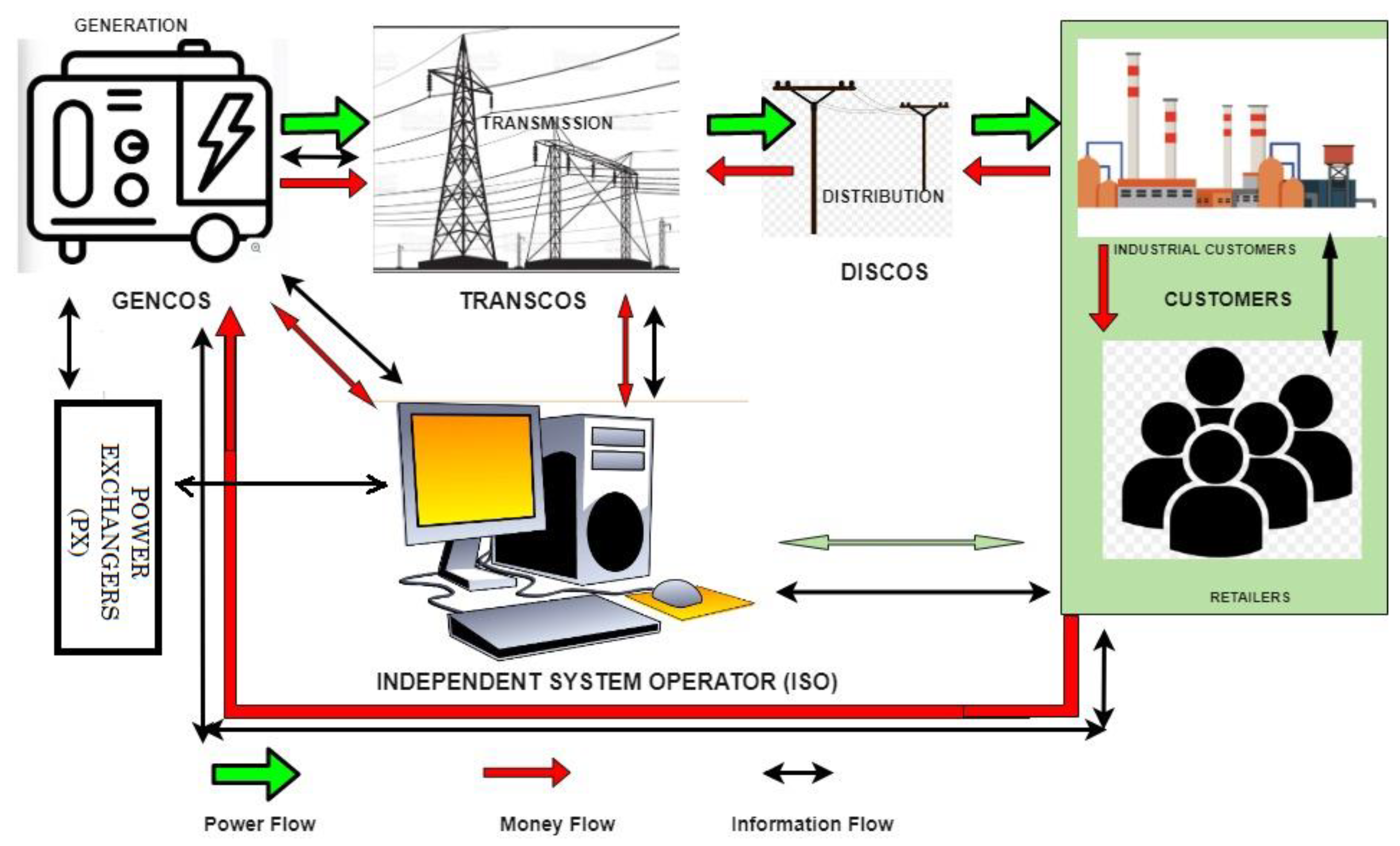

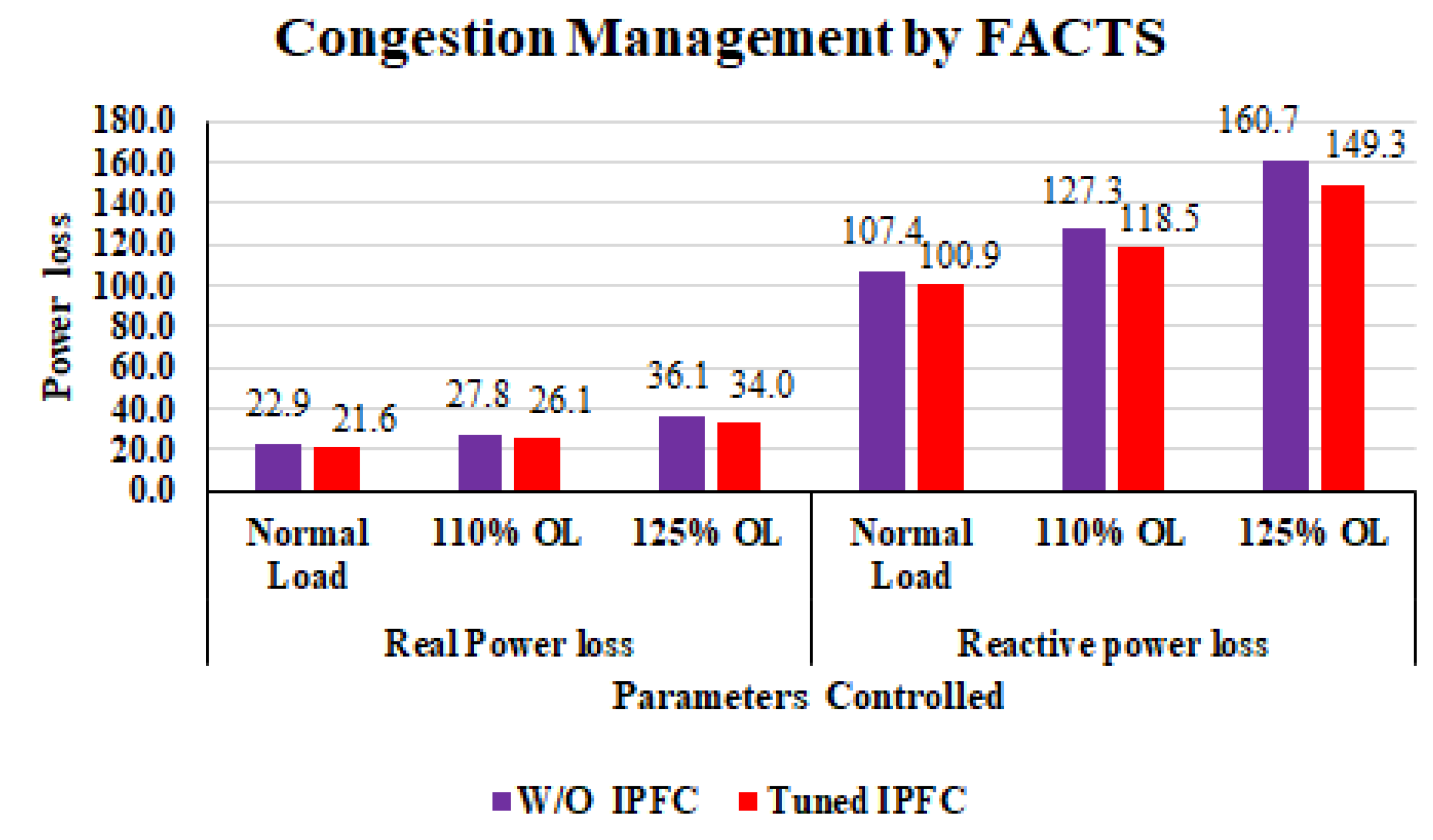
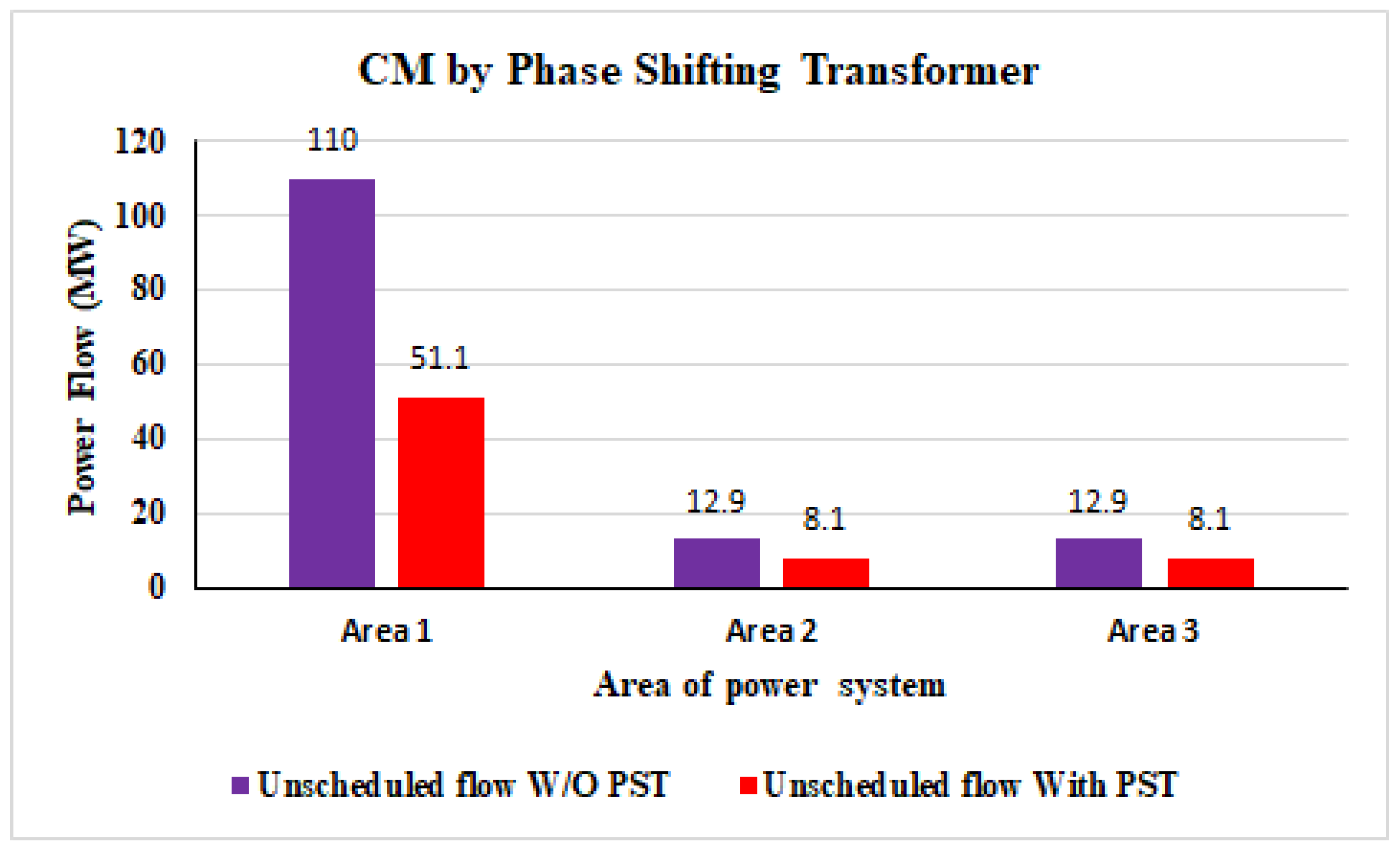

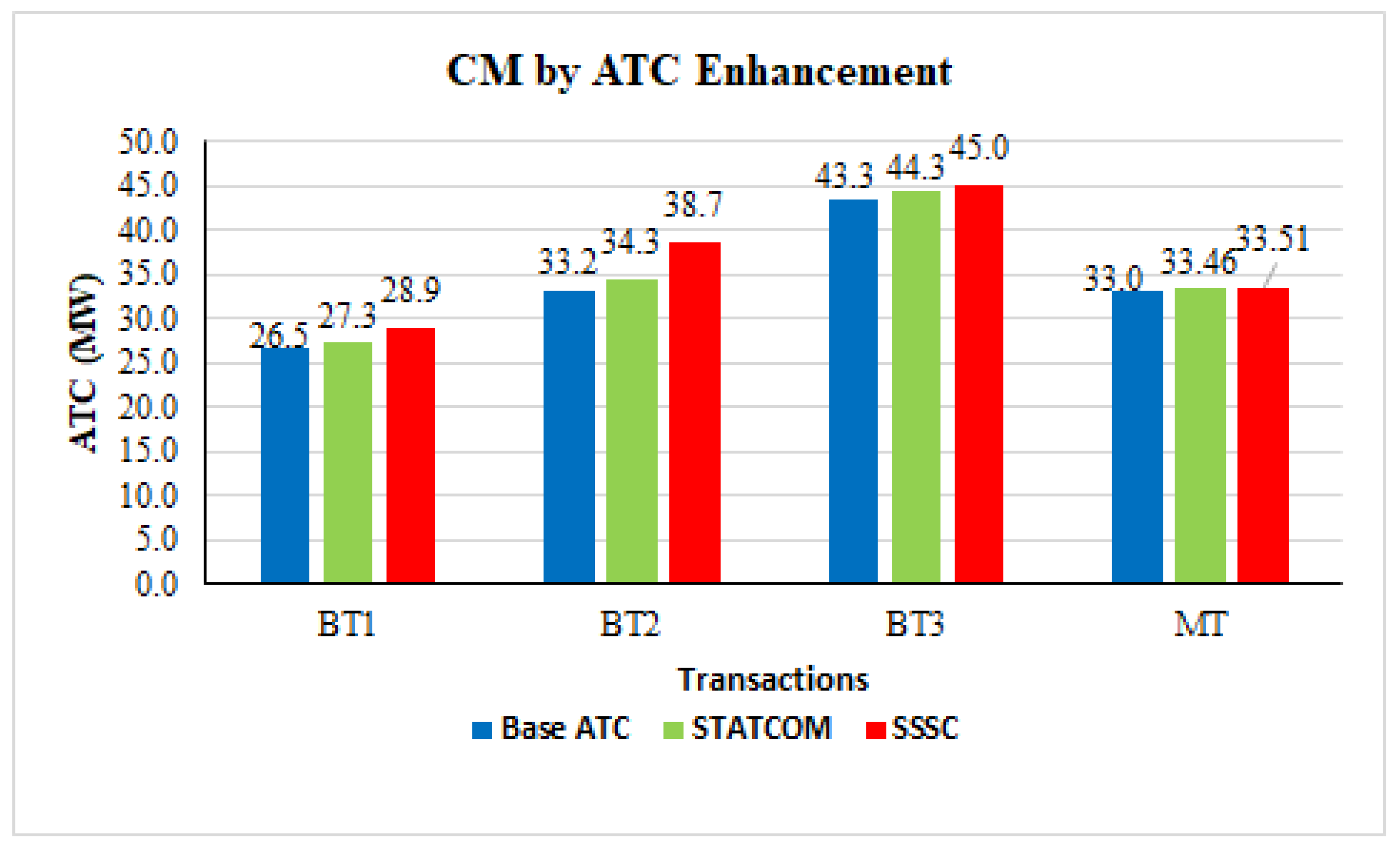
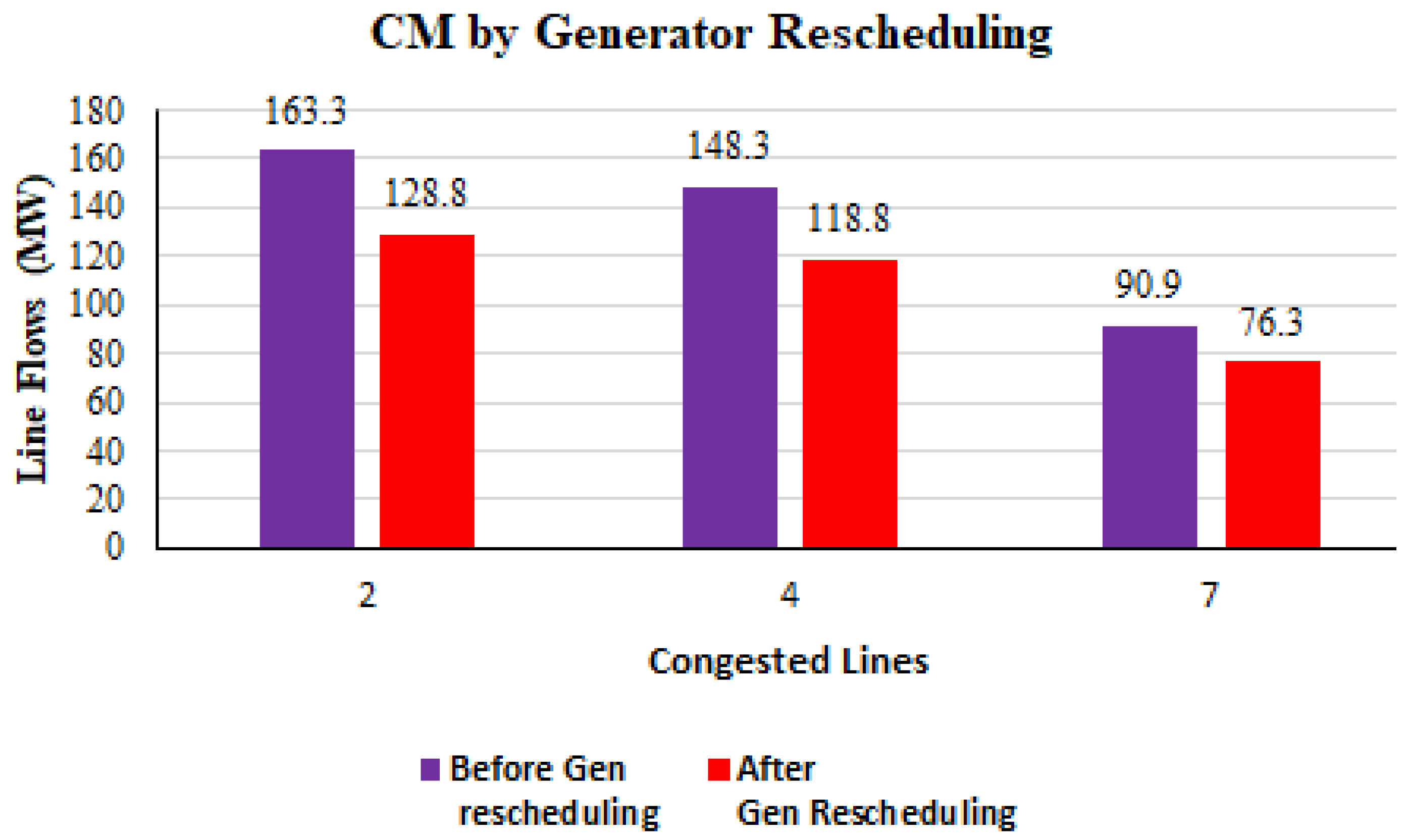
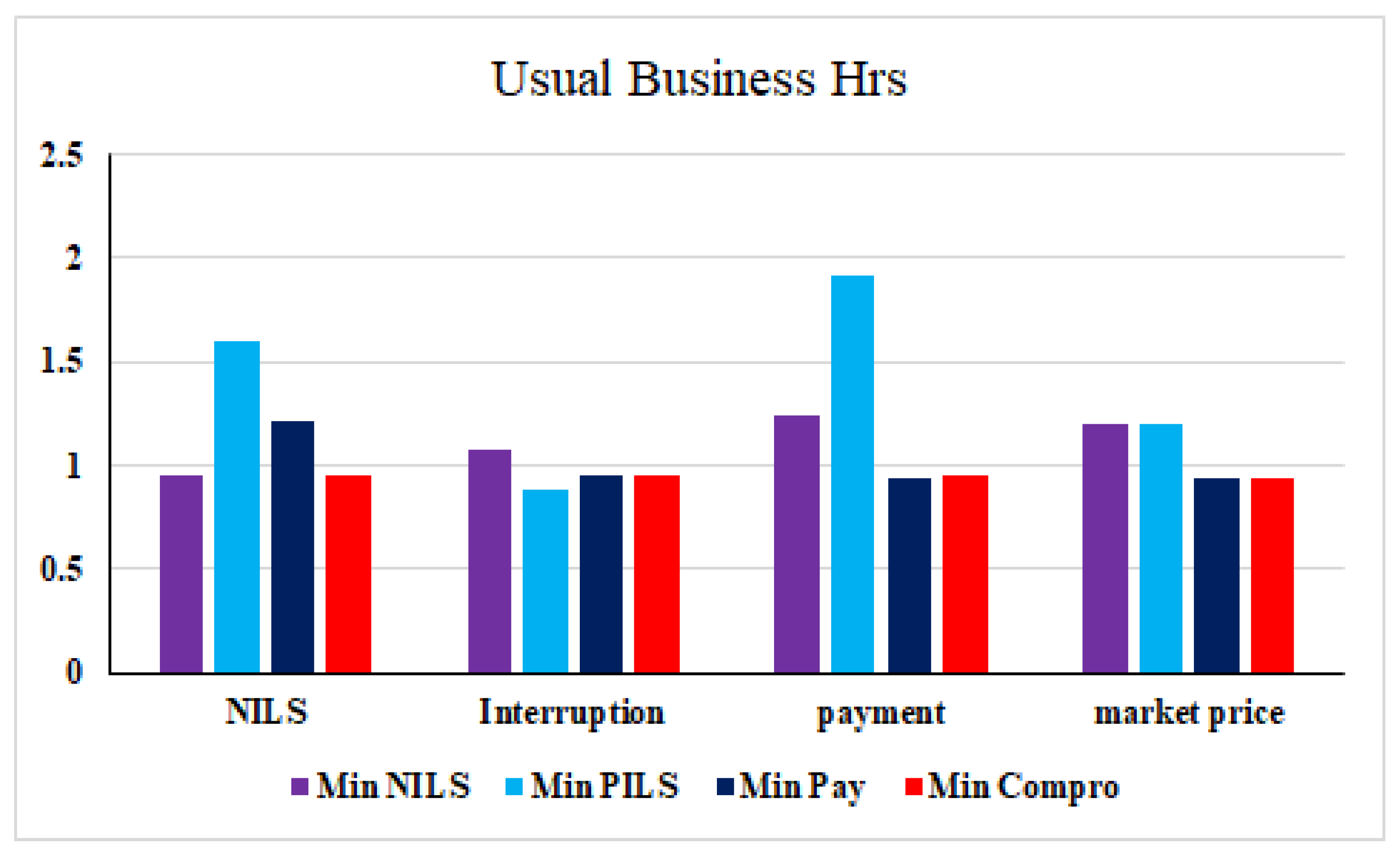
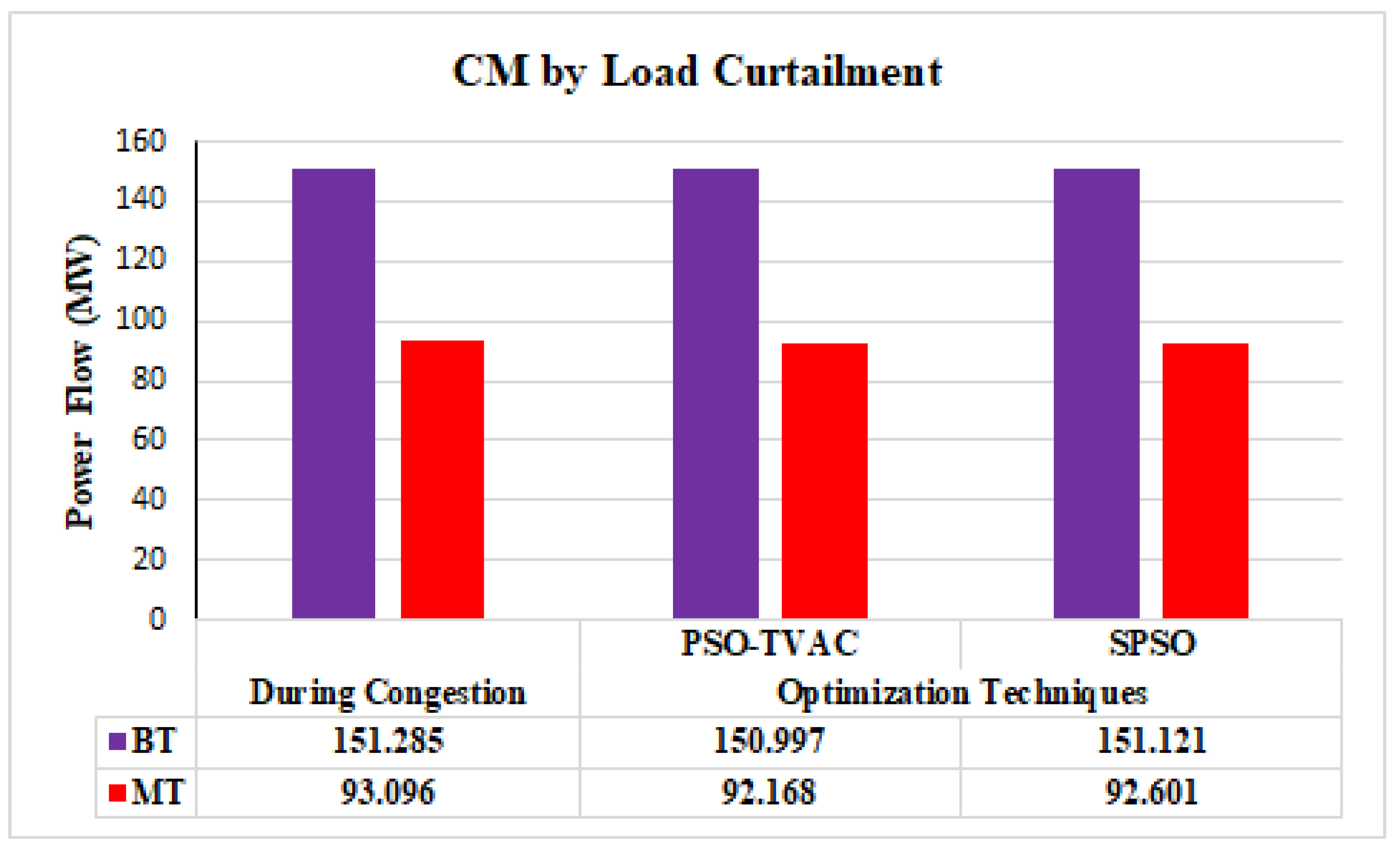

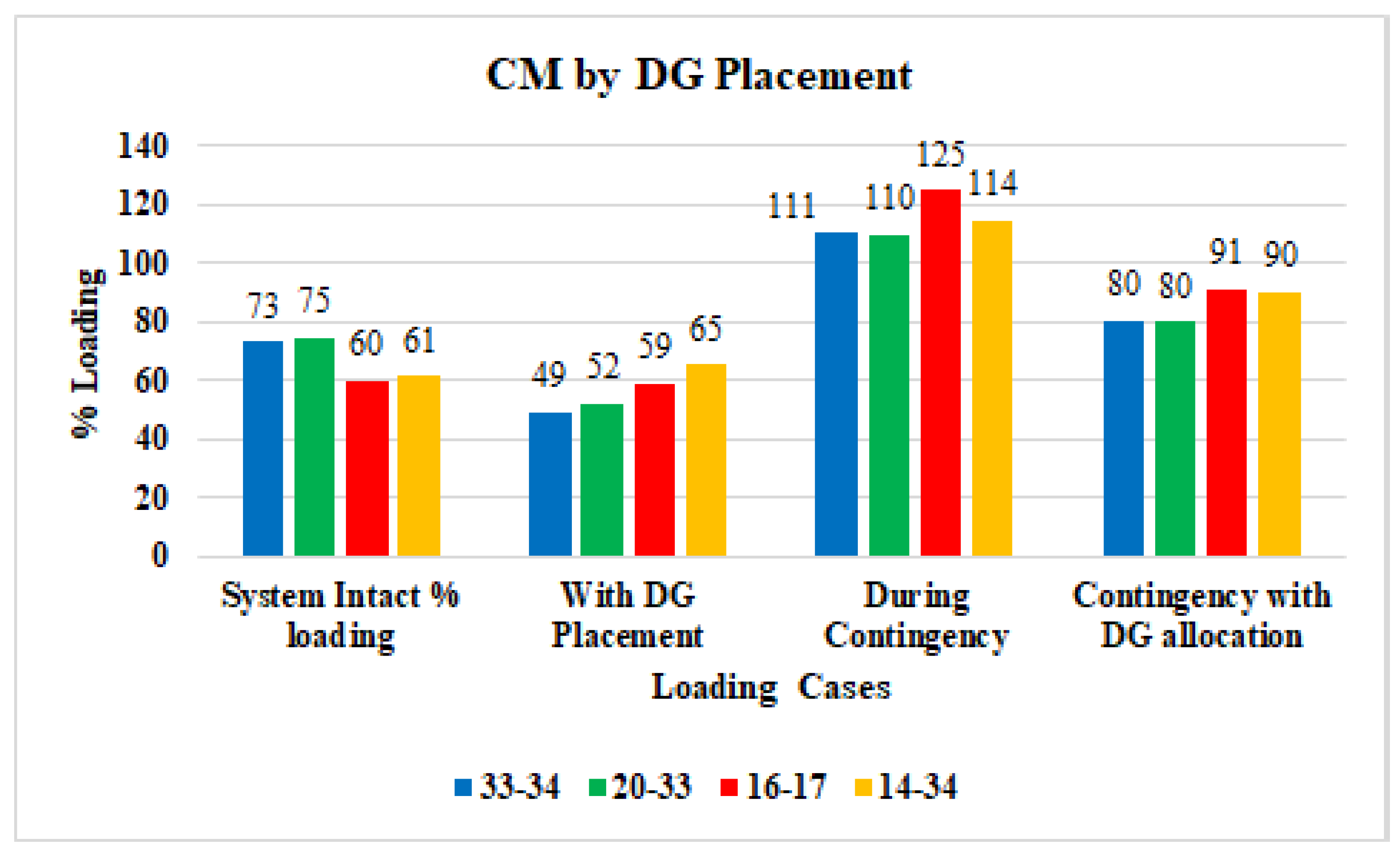
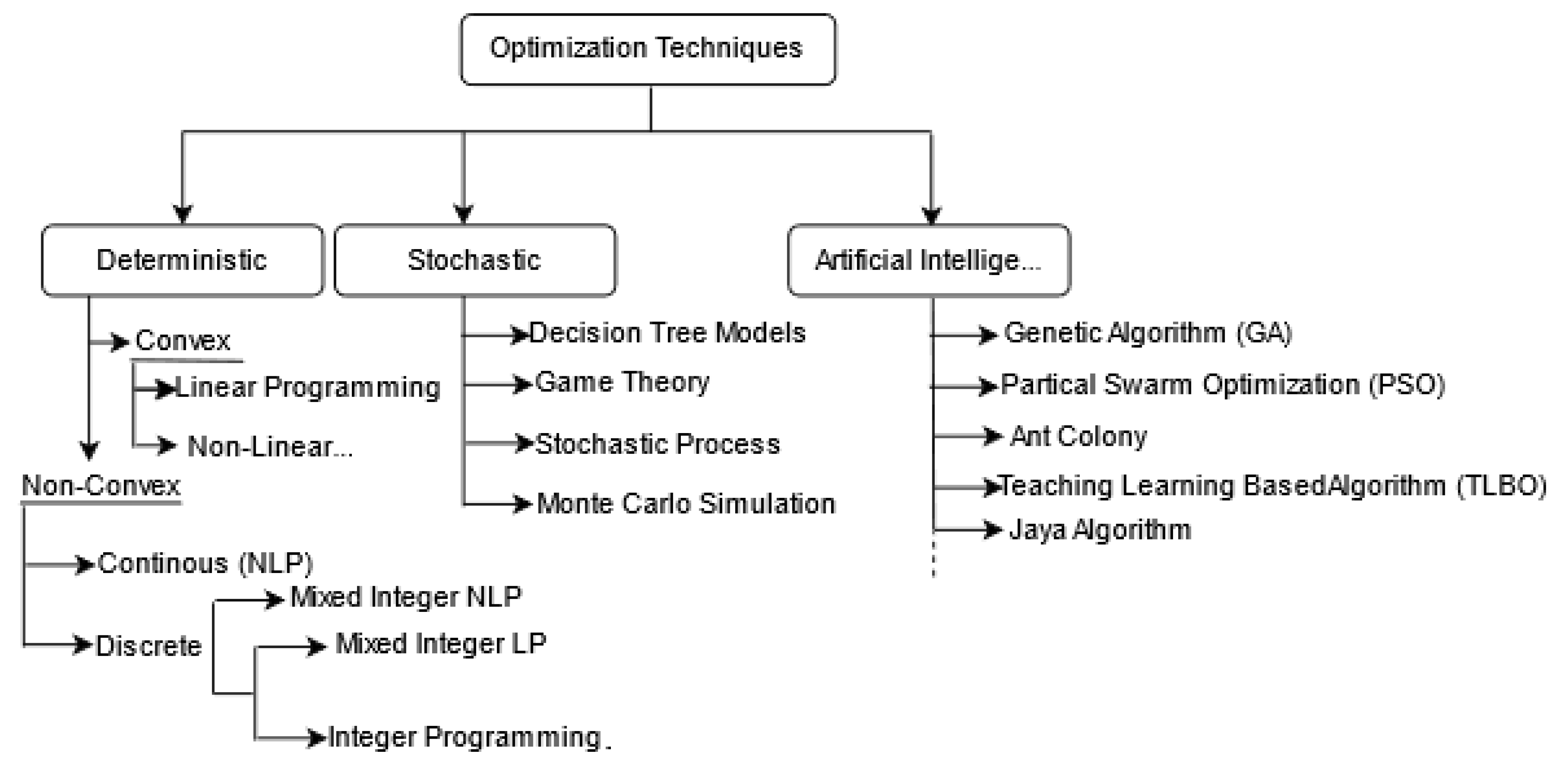
| FACTS Devices | Nomenclature | Position in the EPS | Controlled Parameter |
|---|---|---|---|
| SVC | Static VAR compensator | Shunt | Q |
| TCR | Thyristor controlled reactor | Q | |
| TSC | Thyristor switched capacitor | Q | |
| TSR | Thyristor switched reactance | Q | |
| STATCOM | Static synchronous compensator | Q | |
| TCSC | Thyristor controlled series capacitor | Series | P |
| IPC | Interphase power controller | P | |
| TSSC | Thyristor switched series capacitor | P | |
| TCSR | Thyristor controlled series reactor | P | |
| TSSR | Thyristor switched series reactor | P | |
| TCVR | Thyristor controlled voltage regulator | P | |
| SSSC | Static synchronous series compensator | P | |
| IPFC | Interline power flow controller | Series–Series | P and Q |
| UPFC | Unified power flow controller | Series–Shunt | P and Q |
| S No. | Approaches of CM | Type of CM | Advantages | Disadvantages |
|---|---|---|---|---|
| 1 | FACTS-based CM | Cost-free | Increases the power transfer capacity, stability, and controllability of the networks by series or shunt compensation. | Very costly, needs very precise adjustment of FACTS parameters, a very accurate location is to be determined. |
| 2 | Phase-shifting transformers | Cost-free | Increases the overall capacity of grids, reliable and economic power flow management. | Cannot increase the individual capacity of lines, works effectively under low congestion values. |
| 3 | Network reconfiguration | Cost-free | Reduces line losses, improves voltage profile, reduces peak demand reduction in overloading of distribution lines, reduces in environmental pollution and distribution systems. | The change in configuration of network results in altered node voltage, line currents and degree of unbalances. This also results in the level of distortion of the node voltage. |
| 4 | ATC-based CM | Cost-free | Fruitful for open market trading and maintain economic, reliable, and secure operation over a wide range of system conditions. | Power losses are increased with the increase in ATC. |
| 5 | Generator rescheduling-based CM | Non-cost-free | Efficient congestion mitigation is obtained, reduces the need of load curtailment. | Raises the operating cost of the system due to the out of merit generators are involved more than scheduled generators. |
| 6 | First-come, first-served (FCFS)- and pro-rata method-based CM | Non-cost-free | Beneficial to make long-term predictions, efficient and quick security assessment can be performed, advanced knowledge of trade volume can be obtained. | Makes the networks users economically incompetent in the usage of transmission services. |
| 7 | Auction-based methods | Non-cost-free | Auctions are responsible for the decline in costs. The auction-based method generally runs into system issues and complexities. | |
| 8 | Load curtailment-based methods | Non-cost-free | An effective way for CM in networks with low capacity. | Load curtailment results in economic losses in the system. |
| 9 | NP-based CM | Non-cost-free | Decrease in total generation cost, enhanced flexibility in selecting power injection to alleviate congestion. | The composition of markets in the nodal pricing-based method is not quite accepted when employing bilateral transactions. |
| 10 | DG-based CM | Non-cost-free | Short circuit levels are increased, load losses change, voltage profiles change along the network, voltage transients will appear, congestions can appear in system branches, power quality and reliability may be affected. | Short circuit levels are increased, load losses change, voltage profiles change along the network, voltage transients will appear, power quality, and reliability may be affected. |
| S No | Optimization Techniques | Constraints/Parameters |
|---|---|---|
| 1 | GA | Population size, number of generations, crossover rate, mutation rate, length of block swap over between parents and off-springs. |
| 2 | GWO | Population size. |
| 3 | PSO | Problem dimension, number of particles, acceleration coefficients, inertia weight, neighborhood size, number of iterations, random values scaling depending on cognitive and social components. |
| 4 | TLBO | Number of dimensions, lower bound, upper bound, number of particles and maximum number of iterations. |
| 5 | JAYA | Population size, maximum number of iterations, random values of two random variables between 0 and 1. |
| Author Name and Publication Year | Work Undertaken in Paper | Objective Function | Limitations Observed in the Method Applied |
|---|---|---|---|
| Kaltenbach J C, Peschon J, 1970 [116] | A computational method-based approach is proposed, optimally merging the previously separated load flow calculations, reliability scrutiny, and economic calculations. This procedure is validated on a 17-node system so that the disturbances in heavily loaded lines may not affect the rest of the system. | The function includes the following:
| The results obtained by the 17-node system, which has been tested here, cannot be implemented for a different standard system, authenticated by technical societies. |
| Carson T, Guy S, Adel H, 1994 [117] | The modeling of SVC is described as a standard for electrical utility industries. Apart from transient stability program modeling, long-term dynamic programming is described. | The main objective of this paper is to recommend a standardized model of SVCs. Modelling of transient stability programs and long-time dynamic stability programs are also recommended. | The guidelines given for the correct use of models in power flow programs are not suitable and practical for expanding power systems with increased load demand. |
| Reddy, K.R.S.; Padhy, N.P.; Patel, R.N.N, 2006 [118] | The FACTS device, TCSC and UPFC, is located by LMP difference congestion rent contribution methodologies for mitigating congestion. IEEE 14, 30, and 57 bus systems are used as test systems. |
| The congestion is mitigated by using LMP and congestion rent methods. With the enhanced complexity of the power system, the proposed technique becomes very inefficient and the location of the device obtained is not optimal. |
| Gitizadeh, M., Kalantar, M., 2008 [119] | TCSC and SVC are used to avoid congestion. GA, fuzzy, and sequential quadratic programming are used to obtain the optimal location of FACTS devices. Results validated on the IEEE14 bus system. The objective function is to enhance the voltage stability margin and security margin of the system. | The objective function includes the following: | The algorithm is tested only tested on a small non-complex system and is not validated on a higher-order system. When the location of FACTS is to be optimized for a higher-order system, some alterations are to be undertaken. |
| Hashemzadeh H and Hosseini S H, 2009 [120] | PSO is implemented for locating TCSC to mitigate congestion in the power system by minimizing the cost of congestion and net generation cost. | In this paper, the reduction of total congestion cost and generation cost are the objective functions: , where is the difference in LMPs. | Here, line outage sensitivity factors using the DC power flow method are used to reduce the search space of PSO. This method is suitable for small systems only. In the case of complex systems, the errors due to DC power flow cannot be computed effectively. |
| Mandala M, Gupta C P, 2010 [121] | TCSC is used for reducing transmission losses and generation costs while increasing the loadability of lines with increased stability of the system. The real power performance index (PPI) is the base for the optimal location of TCSC to mitigate congestion. Three locations are obtained by PPI and the optimized location is decided by minimizing production cost using interior-point methods. | This paper includes objective to perform cost benefit analysis of TCSC as
| In large and complex systems, the location of FACTS devices by utilizing sensitivity factors produces an error in the location prediction, unless a penalty factor is incorporated. Here, no such factors are implemented. |
| Vijayakumar K., 2011 [122] | TCSC and UPFC are placed to relieve congestion in IEEE 57 bus system. The location is optimized using GA. | The objective of research is to maximize social welfare with enhance system security: : bilateral transaction between supplier i and consumer j. | Only the technical benefits of TCSC and UPFC are considered here in terms of the loadability of the line. The economical criteria are not considered here. Social welfare maximization and line overloading problems are solved separately in this paper. The two may be considered simultaneously by using other optimization methods. |
| Anwar N, Siddiqui A S, and Umar A, 2012 [123] | FACTS together with power oscillation damper (POD) are implemented here for compensating voltage. UPFC is found to be more suitable for decongesting the bus as compared to SSSC. | The power flow is enhanced to alleviate congestion by using POD with SSSC with function as : measured time constant; : washout time constant; , : lead and lag time constants. | UPFC is quite a costly installation as compared to SSSC. Moreover, it is used with POD which makes the combination not suitable for social welfare. Thus, economic consideration makes this method not appropriate for decongesting the system. |
| Ashwani K, Charan S., 2013 [124] | The third generation of FACTS device, STATCOM, is used in this paper. Its effect on the optimal rescheduling of generators is studied for reducing the congestion cost. Security margin and voltage limits are used here to implement three bid block assemblies. | This paper objective function includes the reduction of fuel cost with the impact of FACTS device on generator rescheduling. | The method applied here gives the most economical congestion costing only when the rescheduling is performed with the incorporation of renewable energy systems. |
| Siddiqui, A.S., Deb, T, 2014 [125] | This paper investigates the effect of SVC, TCSC, and UPFC devices on power flows and bus voltages with increased line loadings. IEEE 14 bus system is tested. | Static modelling of SVC, TCSC and UPFC is undertaken. Under 30% overload condition in steps of 10% increment, the effect of implementation of FACTS devices is validated on IEEE-14 bus system and WSCC 9 bus system. | In this paper, all three devices are used. The series device improved line flow, the shunt device improved the voltage profile, and the series shunt device UPFC managed both. No special method for location was adopted. |
| Singh J G, Singh S N, and Srivastava S C, 2016 [126] | The location of UPFC is determined here by using “PTCDFUs” as the sensitivity factor. The results are validated on the Indian 75 bus system and the new England 39 bus system for CM. | The optimal power flow is formulated to minimize the cost function for generator rescheduling. : bid function; : active power rescheduled. | The congestion cost is reduced and the active power rescheduled is quite low. However, the paper concludes that if the cost of UPFC is considered, this method is not suitable for application. |
| Gupta S K, N. Yadav K, and Kumar M, 2018 [127] | In this paper, IPFC, UPFC, and HVDC are used with generator rescheduling to obtain the congestion cost in the standard IEEE 30 bus system. Here, congestion cost with IPFC becomes less as compared to the other FACTS incorporated. | The objective is to minimize the congestion cost together with the implementation of FACTS. | Generator rescheduling itself is a method of congestion management that includes the cost of rescheduling. Here, this rescheduling is undertaken with the FACTS device. IPFC is a very costly device, which makes the system extremely costly. |
| Farahani V Z and Kazemi A, 2006 [128] | Cost-free and non-cost-free methods are compared to mitigate congestion. Generator rescheduling and load curtailment are compared with the application of FACTS devices for congestion management. | Two objectives are used here for managing congestion. The first is bilateral dispatch with a load curtailment strategy and the second is bilateral dispatch with FACTS devices: is the willingness to pay factor; is the desired value of transaction . | The two methods are compared and both methods are found effective. Only TCSC is applied and compared. The comparison with other FACTS devices may discriminate the effective method. |
| Mohd Isa A Niimura T, Yokoyama R, 2008 [129] | Physical transmission congestion is relieved by curtailing a small portion of the non-firm transactions. The system operator can select the most effective and desirable congestion relief measures. | The objective here is to maximize the total social welfare by maximizing the difference between total supplier cost and total consumer benefit. | Load curtailment is applied together with generator dispatch for mitigating congestion. Generator rescheduling cost is not considered. This makes the system uneconomical. |
| Hazra J, Sinha A K, Phulpin Y, 2009 [130] | In this paper generator re-scheduling and load shedding are presented for CM using the ratio of current concerning bus change injected parameters as a sensitivity factor. | The objective here is to minimize the cost of generation and to minimize the overload. is the amount of load shedding at bus k; , , are the cost coefficient of generator; and , , are the cost coefficient of load shedding at bus k. | Load curtailment is a non-cost-free method for CM. Here, only generator rescheduling is not mitigating congestion, but load curtailment has to be performed. This makes the process uneconomical. |
| Verma S, Mukherjee V, 2016 [131] | In this paper generator rescheduling for active power output is proposed by implementing the firefly algorithm (FFA) for CM. The method is applied in the pool-energy market to reduce the congestion cost. | The objective of this paper is to reduce congestion cost by rescheduling generators while satisfying the constraints. , , and are the cost incurred in rescheduling active power output. | Use of sensitivity factors for the selection of participating generators along with rescheduling may be used instead of only applying FFA. |
| Chintam J, Daniel M, 2018 [132] | This paper proposes a satin bowerbird optimization (SBO) algorithm to mitigate congestion in the DPS. A generator rescheduling-based approach is applied to mitigate congestion. | This paper presents a satin bowerbird optimization (SBO) algorithm to minimize the active power rescheduled to mitigate congestion with the following objective function: , , and are the cost occurred in rescheduling active power. | From the single-objective and multi-objective cases, it can be observed that the objectives are antagonistic, i.e., adversely affect each other during optimizing. The method may be updated to resolve this problem. |
| Entezariharsini A, Ghias I S., Mehrjerdi 2018 [133] | Effects of wind on energy market parameters are studied in this paper. This paper addresses the location and penetration of multi-wind turbines in the power system. Flow-gate marginal pricing (FMP) is examined for a different siting of wind power plants, numbers, and ratings. | The objective of this paper is to minimize the annual operational cost of the generators in the network. The objective function is modeled as | The effect of multiple wind turbines on the system is explored. Several FMPs are made on the high voltage side of the network and no FMP on the lower voltage side. The higher number of FMP is undesirable and has to be examined. |
| Satish K., Ashwani K. 2020 [134] | FACTS devices are implemented here for optimal balancing of different types of loads together with a high penetration of wind power to mitigate congestion. To maintain voltage within limits, different FACTS devices are compared for their performance in achieving the optimized solution of the objective function. | Design of bilateral and hybrid electricity market is discussed. Design of STATCOM, UPFC, SSSC, IPFC and GUPFC is proposed. Sensitivity-based approach for determining the optimal location of FACTS devices is proposed. Impact of different levels of wind power integration is validated and its effect on congestion is detailed. | In this paper, a sensitivity factor-based approach for congestion minimization is presented and implemented for wing-integrated systems (WIS). Induction generators are used in wind turbines, which are consumers of reactive power. To compensate for this power additional FACTS devices are implemented, making the system very costly. |
| Nico B., Tarek AlS K., Wilfried V. S. 2020 [135] | This paper presents an analysis of charging transactions of EVs on a Netherland-based EV company. Different scenarios are proposed to create future charging transaction data based on the data for the previous transactions. This paper concludes that with the larger implementation of shared EVs as ancillary services, the charging demand peaks are reduced, in turn reducing the congestion in the system. |
| This study compares the charging patterns of regular and shared EVs and creates insight into the grid impact and potential to provide ancillary services with the future adoption of shared EVs. Charging optimization methods are not applied to shared vehicles for adopting them as future ancillary services. |
Disclaimer/Publisher’s Note: The statements, opinions and data contained in all publications are solely those of the individual author(s) and contributor(s) and not of MDPI and/or the editor(s). MDPI and/or the editor(s) disclaim responsibility for any injury to people or property resulting from any ideas, methods, instructions or products referred to in the content. |
© 2023 by the authors. Licensee MDPI, Basel, Switzerland. This article is an open access article distributed under the terms and conditions of the Creative Commons Attribution (CC BY) license (https://creativecommons.org/licenses/by/4.0/).
Share and Cite
Gautam, A.; Ibraheem; Sharma, G.; Ahmer, M.F.; Krishnan, N. Methods and Methodologies for Congestion Alleviation in the DPS: A Comprehensive Review. Energies 2023, 16, 1765. https://doi.org/10.3390/en16041765
Gautam A, Ibraheem, Sharma G, Ahmer MF, Krishnan N. Methods and Methodologies for Congestion Alleviation in the DPS: A Comprehensive Review. Energies. 2023; 16(4):1765. https://doi.org/10.3390/en16041765
Chicago/Turabian StyleGautam, Anurag, Ibraheem, Gulshan Sharma, Mohammad F. Ahmer, and Narayanan Krishnan. 2023. "Methods and Methodologies for Congestion Alleviation in the DPS: A Comprehensive Review" Energies 16, no. 4: 1765. https://doi.org/10.3390/en16041765
APA StyleGautam, A., Ibraheem, Sharma, G., Ahmer, M. F., & Krishnan, N. (2023). Methods and Methodologies for Congestion Alleviation in the DPS: A Comprehensive Review. Energies, 16(4), 1765. https://doi.org/10.3390/en16041765









